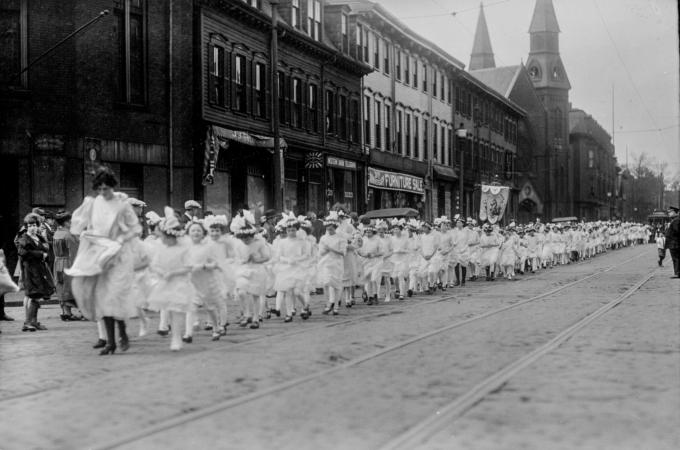The archdiocese's long tradition of May processions
In the Catholic Church, the month of May is dedicated in a special way to the Blessed Virgin Mary. Popular devotional practices that occur during the month of May include processions, the erection of May altars, "May crownings" of statues of Mary, and many other individual and collective activities. Spanning the Easter Season and Ordinary Time, the Marian month is a time to reflect on Mary's active participation in the Paschal Mystery and on the ways in which she continually intercedes for the Church.
In the Archdiocese of Boston, the month of May has historically been a time for Catholics to come together for the joyful, vibrant, and public veneration of Mary. In the late 19th and early 20th centuries, "May Processions" were central to this veneration. Held by ethnic and territorial parishes alike, May processions drew crowds of hundreds and sometimes thousands to the streets to honor the Blessed Mother. They were usually held on a Sunday afternoon and featured young children, dressed in white, parading through the streets around their parish, escorting a statue of Mary. Processions would wind their way back to the parish church, where a young girl would be chosen as "May Queen" to crown the statue with a wreath of flowers. Parishioners would sing Marian hymns and recite prayers to the Blessed Mother, asking for her intercession in the year to come.
Reflecting on the beauty of May processions for the Cambridge newspaper The Sacred Heart Review, the poet Denis McCarthy wrote:
"What is clearer, what is dearer, than the children's voices singing,
As they come with banners waving, as they come with garlands gay
Where the waking buds are breaking and the tender grass is springing,
In our Lady's month of beauty, in our Lady's month of May!"
Beautiful as they were, May processions were much more than mere aesthetic displays. They were elaborate public expressions of faith that encouraged widespread community participation -- just one of the many devotional practices that helped to knit a neighborhood together around a central parish. And, crucially, they allowed laypeople to play the kind of active role in their parishes that we tend to think of as unusual in the pre-Vatican II era.
It would be difficult to overstate the popularity of the May procession in the early 20th century. In 1902, for example, more than 2,000 children marched in the procession organized by St. Mary Church in Lawrence. Alongside the children marched a platoon of police, the city's Brass Band, and St. Mary's Drum Corps. Spectators lined the streets so thickly that it was difficult for the procession to get through the crowd. In 1920, a crowd of 4,000 gathered in Cambridge to witness the procession of 1,500 children from St. Mary's Parochial School. These children returned to their parish, where the little girl chosen as May Queen crowned the statue of Mary, and all "massed before the altar and sang hymns of rejoicing."
In 1912, Most Holy Redeemer and Sacred Heart Churches in East Boston held their May processions on the same Sunday. 1,000 children from the former church and 750 from the latter participated in the simultaneous processions, which traversed different routes and effectively halted traffic in East Boston for part of the afternoon. This was nothing compared to the commotion that would ensue when, in 1928, six South Boston churches held their processions simultaneously. More than 7,000 children marched on that day, when unprecedented throngs of Catholics flocked to the streets to honor the Blessed Mother.
These massive displays of religious identity required a remarkable amount of behind-the-scenes planning. A patchwork of overlapping groups, including religious sisters, ladies' sodalities, fraternal organizations, teachers, parents, and musicians coordinated to pull off these events. In doing so, these groups collectively shaped devotional practices, which varied from parish to parish and city to city. In some places, young children carried wheat and grapes to symbolize and emphasize the Eucharist. In others, devotions to St. Joseph were added to accompany the Marian celebrations. Many churches chose to focus on a particular Marian title, such as "Star of the Sea," "Our Lady of the Immaculate Conception," or "Our Lady of the Assumption" as a sort of theme for the procession. No two processions were the same, just as no two communities and no two parishes were the same.
Many historians of Catholic history have chronicled the decline in popular devotional practices like the May procession that took place in the mid- to late-20th century, as the internal changes in worship brought about by Vatican II combined with the cultural and social changes of the 1960s and 1970s. But it is worth noting that May has never ceased to be "Mary's month." In May, parishes continue to honor the Queen of Heaven, to meditate on her love for Christ and His church, and to pray for her continual intercession.
VIOLET HURST IS AN ARCHIVIST FOR THE ARCHDIOCESE OF BOSTON.



















